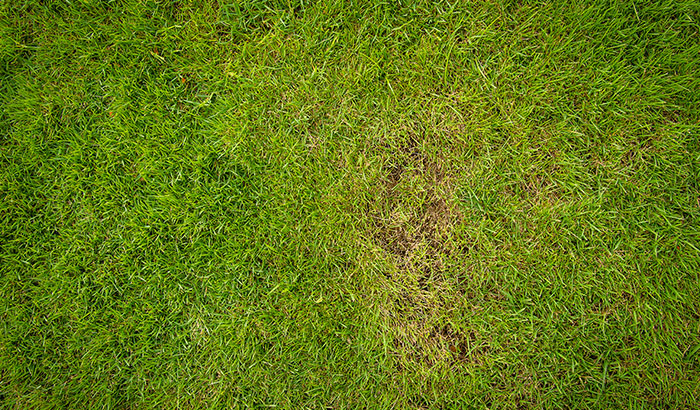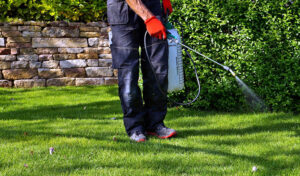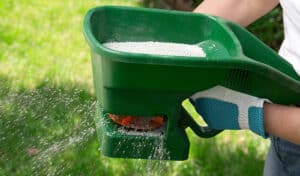Maintaining a pristine yard can feel like a full-time job, especially when you have a diseased lawn, but we’re here to help make it easier.
Lawn disease control in your yard can be challenging until you understand how to identify the disease as well as the causes and prevention methods. Is it a brown patch or a summer patch? Is it a fungal infection or the result of a stray dog? Fortunately, with a little TLC, your lawn can remain disease-free.
Continue reading to learn about nine types of lawn disease and seven crucial steps to combat them.
What are the Different Types of Lawn Disease?
A diseased lawn comes in different shapes and sizes. Here are a few common lawn diseases you should know about:
- Brown patch: It’s not tough to spot a brown patch. This is a fungal disease that causes circular, brown patches to form on the lawn.
- Dollar spot: Dollar spot is a fungal disease that causes small, silver dollar-sized spots to form on the lawn.
- Powdery mildew: This is a fungal disease that creates a white or gray powdery coating on the grass blades.
- Rust: Rust causes grass blades to turn yellow or orange and develop a rust-like appearance. Rust disease shows up near the beginning of fall when temperatures start to dip and days are shorter.
- Red thread: Red thread causes pink or red thread-like structures to grow on the grass blades. The red thread appears in the form of small red patches about 4 inches long. The disease thrives in temperatures ranging from 40 to 80 degrees Fahrenheit and is often found on wet leaves.
- Pythium blight: Pythium blight causes the grass blades to turn brown and slimy, often in low-lying, poorly drained areas. This disease thrives in humid environments. Damp weather encourages the spread of the fluff balls, which can even turn them into a web-like substance.
- Fusarium patch: This is a fungal disease that causes circular, reddish-brown patches on the lawn.
- Anthracnose: Anthracnose causes irregular patches of dead or dying grass, often in the shape of a “V”.
- Snow mold: Snow mold occurs in the winter months and causes a gray or pinkish-white mold to form on the lawn.
You must properly identify the type of disease affecting your lawn to be able to select the appropriate treatment.
What Causes Lawn Disease?
A diseased lawn can be caused by a variety of factors, including environmental conditions, cultural practices, and pathogenic microorganisms like fungi, bacteria, and viruses. Understanding what causes lawn disease will help you out with your lawn care strategy.
Some common causes of lawn diseases include:
- Moisture: Many lawn diseases thrive in wet conditions, such as during periods of heavy rain or in areas with poor drainage.
- Temperature: Different lawn diseases have varying temperature requirements, and some are more common in warm or cool weather.
- Soil conditions: Certain lawn diseases are more likely to occur in soils with poor fertility, low pH, or poor drainage.
- Mowing height: Mowing your lawn too short can weaken the grass and make it more susceptible to disease.
- Fertilization: Overuse or improper use of fertilizer can create imbalances in the soil, which can contribute to disease development.
- Traffic: Heavy foot traffic can damage the grass and create opportunities for disease to take hold.
- Plant selection: Choosing grass varieties that are not well-adapted to your climate or soil conditions can make them more vulnerable to disease.
- Pathogens: Fungal, bacterial, and viral pathogens can infect the grass and cause disease, often spreading through contaminated soil, equipment, or plant debris.
By identifying and addressing the underlying causes of lawn diseases, you can take the necessary steps to prevent them and improve your lawn care routine.
What Are the Steps to Cure Lawn Disease?
Lawn disease control will depend on the specific disease affecting your lawn; however, here are some general steps that can help address most lawn fungi:
- Identify the disease: Proper identification of the disease is needed to select the proper treatment. Consult with a lawn professional, if needed, to identify the problem.
- Improve cultural practices: Making changes to your lawn care practices can help prevent the disease from spreading and encourage grass recovery. Some steps might include adjusting your watering schedule, mowing height, and fertilization practices.
- Apply fungicide: If the disease is caused by a fungus, applying a fungicide can help control the spread of the disease. Make sure to choose a fungicide that is labeled for the specific disease and follow the instructions carefully. Always follow the instructions on the product label when using fungicides.
- Remove infected grass: If the disease has caused significant damage to the grass, it might be necessary to remove and replace the infected areas with new grass or seed.
- Prevent future outbreaks: After the disease has been treated, it’s time to take steps to prevent future outbreaks. This can include adjusting cultural practices, improving soil health, and using disease-resistant grass varieties.
- Reseed or sod: Once the disease has been cured, you may need to reseed or sod the affected area to restore your lawn to its previous condition.
- Monitor the lawn: Keep an eye on the lawn to ensure that the disease does not return. Regularly inspect the grass for signs of disease and address any issues promptly.
The best course of action for lawn care will depend on the specific disease affecting your lawn, so consult with a lawn care professional for guidance on the best treatment approach.
Summit Lawn & Pest Control Can Help You Rid of Lawn Disease
A diseased lawn is no laughing matter. If you need help with lawn disease control or prevention, Summit Lawn & Pest Control is here to help! Our mission is to provide excellent service at reasonable prices to our clients.
Schedule your free assessment with Summit Lawn & Pest Control today! In Utah County, Utah, we serve Lehi, American Fork, Provo, Springville, Spanish Fork, and the surrounding cities.







